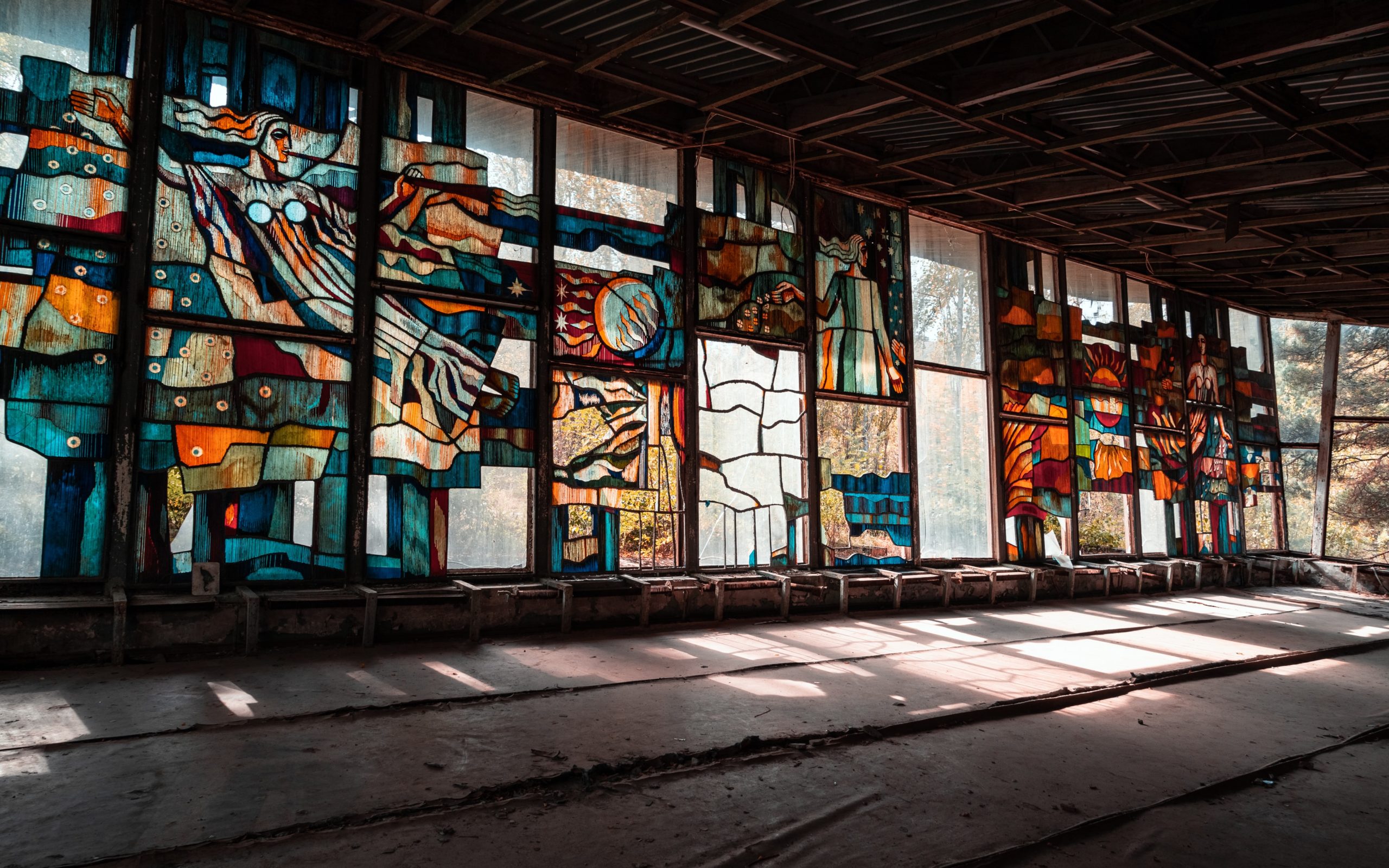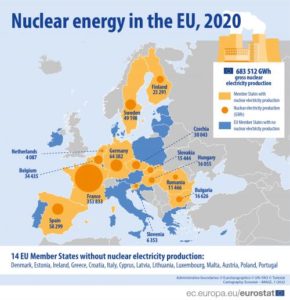Soon after Russian forces had taken control of the Chernobyl site on Feb. 24, 2022, SaveEcoBot, an online radiation monitoring site in Ukraine, recorded an exceptional jump in the radiation counts of 65,500 nSv/h at the site at around 9:50 pm (local time). Another concerning increase of 93,000 nSv/h was recorded at 10:40 am on Feb. 25, 2022. While the rise in radiation counts was troubling, the absence of updated radiation data for two days after the increase was even more disturbing.
The unprecedented large-scale nuclear catastrophe at Chernobyl in 1986 released a large amount of radioactivity, and was even detected as far as 8100 km (more than 5000 miles) away, at Kyoto University Research Reactor Institute in Japan, on May 3, 1986, just a week after the beginning of the nuclear catastrophe. Even though the radioactivity gradually decreased over the weeks, Japanese scientists documented another increase at the end of May 1986. The Japanese scientists concluded that the radioactivity from Chernobyl had circulated the earth and returned to Japan. The UN Scientific Committee on the Effects of Atomic Radiation assesses that “radionuclides from the Chernobyl release were measurable in all countries of the northern hemisphere.”
The world mustn’t experience this kind of radioactive fallout again.
CALLING FOR IMMEDIATE ACTION
After Russian forces took over the nuclear facility at Chernobyl, and without any subsequent data that suggested the radiation levels went down later, concerned activists and scientists met online. They shared concerns about the situation at the Chernobyl site and other nuclear facilities in Ukraine. After the meeting, our group, the Manhattan Project for a Nuclear-Free World that focuses on raising awareness about the consequences of nuclear energy and nuclear weapons, and a handful of concerned groups around the world, drafted and submitted an open letter to the International Atomic Energy Agency (IAEA) on Mar. 1, 2022. We sent it to the IAEA’s Board of Governors before their emergency meeting on the situation in Ukraine, which was scheduled for Mar. 2, 2022.
The ongoing situation in Ukraine confirms that nuclear reactors and radioactive waste disposal sites could be weaponized or accidentally damaged, which would result in widespread radioactive contamination.
We called on the IAEA to do five things in the open letter. The first was to determine who is currently responsible for the operation and the radiation safety of the Chernobyl site and investigate their degree of technical capability to deal with nuclear emergencies. Second, conduct assessments to identify the necessity to send additional nuclear technicians to maintain the safety of the Chernobyl site. Third, investigate and establish the status of Ukraine’s 15 reactor sites to ensure their continued operation under qualified personnel. Fourth, ensure transparency and protect the right to information of local people by promptly publishing all relevant data and information, in the local language and English, regarding the radiation safety of all nuclear facilities and nuclear power plants in Ukraine. And fifth, request IAEA member states, particularly those who are part of the conflict, to refrain from any military or other action that could threaten the nuclear facilities’ safety in the conflict zone.
In the letter, we also highlighted concerns raised by Beyond Nuclear, a nonprofit advocating for a sustainable and democratic energy future. All nuclear reactors in Ukraine are vulnerable to catastrophic meltdowns even if they are not directly attacked or accidentally hit. And more importantly, a nuclear power plant cannot be abandoned under any circumstances.
WHERE ARE IAEA’S INSPECTORS?
Ukraine has 15 commercial nuclear reactors at four nuclear power plants in addition to the decommissioning reactors at the Chernobyl site.
A couple of days after the letter was published, there was a report that a projectile had hit a building near the Zaporizhzhya Nuclear Power Station in southeastern Ukraine, which is the largest in Europe and among the 10 largest in the world. There was also news of a nuclear research facility in Kharkiv in the northeast of Ukraine, where radioisotopes for medical and industrial applications were being produced, had been damaged by shelling. Another report documented missiles hitting the site of a radioactive waste disposal facility in Kyiv, the capitol.
In addition to nuclear reactors that could release a large amount of high-level radioactivity into the environment, radioactive waste disposal sites that store highly radioactive wastes, such as spent fuel from nuclear reactors, are also vulnerable to catastrophic radioactive discharge. Spent fuel usually sits in dry cask storage near nuclear power plants in Ukraine. Holtec International, a New Jersey-based company, built Central Spent Fuel Storage Facility inside the Chernobyl Exclusion Zone near the Chernobyl site in November 2021 for Energoatom, Ukraine’s national nuclear energy company.
The ongoing situation in Ukraine confirms that nuclear reactors and radioactive waste disposal sites could be weaponized or accidentally damaged, which would result in widespread radioactive contamination. However, despite these concerns, the IAEA could not send a delegation to Ukraine to investigate the situation until late March 2022, when Director-General Grossi traveled to the South Ukraine nuclear power plant. Furthermore, the IAEA could not send a team to the Chernobyl site until Apr. 26, 2022, more than two months after the exceptional radiation increase was detected on Feb. 24, 2022.
Unfortunately, the situation in Ukraine has demonstrated that the IAEA does not have a system in place to send a team of nuclear technicians to facilities to mitigate an emergency. This is an extremely concerning issue, especially as the IAEA-led global nuclear industry promotes nuclear energy as a “peaceful use of nuclear” in politically unstable regions, such as the Middle East, Central Asia, and Africa.
NUCLEAR REACTORS ARE THE REAL THREATS
The concerning situation at nuclear power plants in Ukraine was foreseeable. Nuclear power plants always have risks of terrorist attacks. For example, the 9/11 Commission Report released in 2004 revealed that the mastermind of the 9/11 attacks considered targeting a nuclear power plant near New York City: “…Atta also mentioned that he had considered targeting a nuclear facility he had seen during familiarization flights near New York — a target they referred to as ‘electrical engineering.’”
The 9/11 Commission, therefore, exposed how vulnerable the Indian Point nuclear power plant made New York City. Being only 25 miles north of the city meant that a terrorist attack could impact the 20 million people who live or work within a 50-mile radius of the plant, including people in New York, New Jersey, and Connecticut. It would also be impossible to evacuate such a substantial number of residents in a timely manner. The movement to shut down Indian Point gained more momentum in the wake of the 2011 nuclear disaster at the Fukushima Daiichi in Japan. Thanks to persistent activism by local groups, the last nuclear reactor at Indian Point was permanently shut down on Apr. 30, 2021.
Damaged nuclear power plants or radioactive storage sites could result in a devastating radioactive discharge into the environment, contaminating air, water, soil, and food. In addition, radiation exposure from radioactive fallout will add to human health risks. World War II could have made Europe uninhabitable due to radioactivity for decades or more if they had the same number of nuclear power plants during the war. It is safe to assume that the fear of radioactive contamination is one of the main reasons behind rejecting no-fly zones or expansion of military activities in Ukraine that could escalate to a nuclear war.
We tend to debate about a nuclear war caused by nuclear weapons, but we do not need a nuclear weapon to bring about a catastrophic radioactive impact in the region. Nuclear power plants are pre-deployed weapons of mass destruction that are vulnerable to catastrophic nuclear disasters even if they are not directly attacked or accidentally hit. Loss of electricity or human error has caused a large-scale nuclear disaster, as we have seen at Fukushima Daiichi, Chernobyl, Three Mile Island, and other locations.
THE NUCLEAR BAN TREATY
Professor Robert Jacobs’ research highlights how nuclear energy was created to kill people. The first modern nuclear power plants built at Hanford in Washington state developed the plutonium for the first nuclear testing at Trinity site in New Mexico and the atomic bomb that destroyed the lives and health of people in Nagasaki in 1945. According to Jacobs, nuclear power plants were invented and “developed to produce nuclear weapons for use against a civilian population in war” to kill masses of human beings. Generating electricity, therefore, is a secondary purpose of this technology.
Why do we continue to allow the narrative that erroneously describes the use of nuclear energy as “peaceful” when the origin, existence, and potential of nuclear power are all extremely violent?
Nuclear energy also undermines democracy. Similar to the violent origin of nuclear weapons, nuclear power is deeply rooted in systemic racism and nuclear colonialism, which continues to disproportionately impact marginalized communities of color, Indigenous Peoples, and those with limited resources. For example, uranium mining for nuclear fuel is a highly extractive process that severely affects the health of residents. As a result, a large-scale nuclear accident would disproportionately affect members of marginalized communities, pregnant people, mothers, and children. In addition, highly radioactive waste from nuclear reactors is is planned to be stored in vulnerable communities of color.
On Jan. 22, 2021, the UN Treaty on the Prohibition of Nuclear Weapons, also known as the “nuclear ban treaty,” entered into force. It outlawed nuclear weapons under international law for the first time. It also aims to eliminate nuclear weapons by emphasizing deep concerns about the catastrophic humanitarian consequences of any use of nuclear weapons, such as exposure to ionizing radiation. The treaty also recognizes the “disproportionate impact of nuclear-weapon activities on indigenous peoples” and the disproportionate impact of ionizing radiation on “women and girls.” Article 6 of the treaty discusses the positive obligations of state parties to adequately “provide age- and gender-sensitive” victim assistance and environmental remediation in communities “affected by the use or testing of nuclear weapons, in accordance with applicable international humanitarian and human rights law.” There are 86 signatories and 61 state parties as of Jun. 4, 2022.
The Nuclear Ban Treaty’s humanitarian approach is a progressive shift from the Treaty on the Non-Proliferation of Nuclear Weapons (NPT), whose main objective is to prevent the spread of nuclear weapons and weapons technology while promoting nuclear disarmament and nuclear energy. But its stance on nuclear energy will limit its ability to achieve its goals under Article 6 effectively. Furthermore, a part of its preamble states that “nothing in this Treaty shall be interpreted as affecting the inalienable right of its States Parties to develop research, production, and use of nuclear energy for peaceful purposes without discrimination.” What this really means is that the treaty does not explicitly prohibit providing uranium to nuclear-armed states, even though global uranium trade assists in developing and producing nuclear weapons.
NEXT STEPS
Why do we continue to allow the narrative that erroneously describes the use of nuclear energy as “peaceful” when the origin, existence, and potential of nuclear power contains so much violence?
Since the first nuclear reactor produced plutonium for nuclear weapons to kill civilians in war, nuclear energy inherited its worst violent traits from nuclear weapons. And now, the situation in Ukraine reaffirms that nuclear energy and radioactive waste storage sites could also be weaponized or accidentally cause devastating radioactive fallout in the region, which could impact the health of a large population and future generations.
Before it is too late, we must shift the inaccurate mainstream narrative of nuclear energy from “peaceful” to “violent.”
Mari Inoue is an attorney and co-founder of the Manhattan Project for a Nuclear-Free World, a volunteer-led grassroots group in New York City. She has been active in grassroots movements to educate policymakers and elected officials on nuclear weapons and nuclear energy’s costs, risks, and humanitarian consequences.























